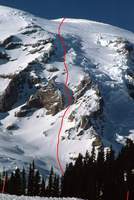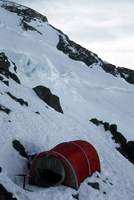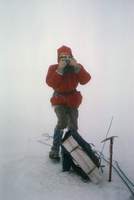Rainier:
Fuhrer Finger
28–30 May 1971
While one might guess that the name of this route was intended as an
affront to a famous Nazi leader,
it was named after the leader of the first ascent: Hans Fuhrer.
The first ascent was on 2 July 1920,
which further dissociates it from any Nazi connection.

Bob Sloan and I had the intention of climbing Rainier via the Fuhrer Finger
route and spending a night on the summit if conditions permitted.
We also thought we might explore or even stay in the
caves
under the summit ice cap.
We left from the Paradise parking lot at 6:00pm on 28 May 1971,
crossed the Nisqually Glacier and made camp at about 7,000 feet.
The appeal of the Fuhrer Finger route is the very direct line it takes.
This direct line
(approximated by the red line in the picture)
makes it the shortest route to the summit.
There is no great technical difficulty to the route,
but its consistent 35-40° slope makes it difficult to find any places
to rest or camp.
It is also subject to great rockfall and avalanche danger.

We left at 6:00am the next morning and started our trek up the
moderately steep slopes.
By 10:00am we were at 9,700 feet,
where we took an extended break.
Since our intent was to stay on the summit we were taking our time to
acclimate to the altitude.
We melted snow,
lunched and relaxed until 1:00pm before resuming the climb.
By this time,
the snow was quite slushy and required a lot of effort to make headway.
Lack of suitable high camp sites is one reason few people take this route.
The truth of this was apparent when we found ourselves at 12,000 feet
wanting to make camp.
We chose a spot with rock outcrops,
thinking there would be less avalanche danger there.
We hacked a small level spot out of the snow and ice;
the size of the platform was severely limited by the rocks in the snow.
By 6:30pm we were ready to start preparing dinner and then to bed.
We put as many anchors as we had into the snow above the tent and ran
a rope from them into the tent and around our waists in case we rolled
over in our sleep.

We started for the summit at 6:00am the next morning.
Low clouds that had hovered around 7,500 feet since the previous morning
were still around.
The high overcast from yesterday was gone.
We took a leisurely pace to the summit,
arriving at 10:30am–
just as the overcast returned and engulfed the summit.
The mist was freezing to our clothing and the moisture from our breath
froze to our goggles, making visibility worse.
The wind was about 30mph and the temperature 10°F;
this would be fine for an overnight stay,
but we could not see what weather might be developing so we decided to
descend right away.
May is too early to take chances with weather in the Cascades;
perhaps I had nagging thoughts about almost exactly two years ago on
Mount Baker.
One of the advantages of descending the Fuhrer Finger route derives from its
disadvantage going up:
we were able to make long glissades on the continuous moderate slopes.
Even after hiking back up to Paradise from the Nisqually,
we were back at Paradise in 5 hours with little effort.


